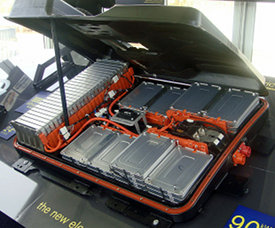Did your parents ever tell you, "Slow and steady wins the race"?
It can be annoying to hear as a child, but often it's true--and in the case of electric car batteries, it's how they'll get less expensive.
As a new posting from the Washington Post's Wonkblog points out, there is no Moore's Law for batteries.
That's the law underlying the rapid improvement of consumer electronics like mobile phones and computers, which says the number of transistors in a microelectronic device roughly doubles every 18 months.
Run that rate over many years, and you get order-of-magnitude improvements in performance or better from decade to decade.
The post cites a recent National Academy of Sciences study, which concludes: "Scientists and battery experts, who have been optimistic in the recent past about improving lithium-ion batteries and about developing new battery chemistries—lithium/air and lithium/sulfur are the leading candidates—are considerably less optimistic now."
We haven't seen quite such pessimism in our interviews with battery experts, both from cell fabrication companies and automakers.
Instead, there's a broad consensus that electric-car batteries of any given chemistry will make slow, incremental improvements in performance from minor improvements to their chemistry and better manufacturing techniques.
We wrote last year that the rate of improvement in large-format lithium-ion cells, the kind used in electric cars, is likely to mirror that of small format cells since 1989: 6 to 8 percent a year.
That rate is depicted, more or less, in a chart from a 2009 study done at Duke University.
And there's still huge room for improvement in existing battery costs simply due to economies of scale as the number of plug-in electric cars built rises.
Last year, there were roughly 53,000 plug-in cars sold in the U.S. and, according to analysts, a total of more than 100,000 globally.
With the exception of the highest-volume vehicles--currently the Nissan Leaf, at 50,000 after two years and counting--and the Chevrolet Volt, most plug-ins don't use large enough numbers of cells to justify truly efficient high-volume manufacturing.
But take that total to 1 million vehicles or so in a few years, and there will be enough volume for the largest cell makers to operate at a more efficient level.
Automakers will likely use some of the improvement to fit larger battery packs for longer range, trading off cost reduction and range increases.

Lithium-ion battery pack of 2011 Nissan Leaf, showing cells assembled into modules
Meanwhile, analysts have revised their estimates of future battery costs downward.
As the Wonkblog post notes, McKinsey & Company released a 2012 analysis that "predicted that the price for lithium-ion batteries could fall by as much as two-thirds by 2020...to around $200 per kilowatt-hour."
The U.S. Environmental Protection Agency, in turn, estimates that a new gasoline-powered car in 2025 will cost $3,000 more in real dollars than it did in 2012, due to the cost of new technologies to meet strict corporate average fuel economy rules.
The automakers we've talked to consider that estimate to be a best-case scenario. Some have said they feel the real cost could be as high as twice that number.
So with battery prices falling--slowly but steadily--and conventional cars getting more expensive, there's likely to come a tipping point for electric-car adoption.
It won't be this year, or next year, or even 2015. But around 2020, things should get pretty interesting.
Maybe your parents were right after all.
+++++++++++













